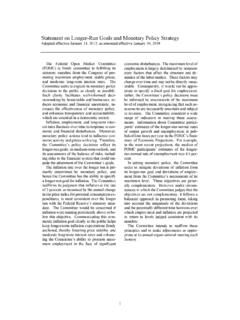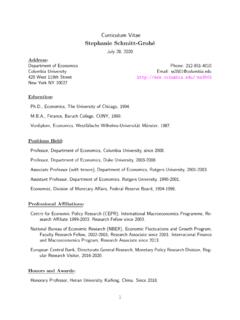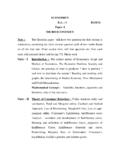Transcription of Trends in crypto-currencies and blockchain technologies: A ...
1 Trends in crypto - currencies and blockchain technologies : Amonetary theory and regulation perspectiveGareth W. Peters ? Efstathios Panayi Ariane Chapelle Department of Statistical Science, University College London?Associate Fellow, Oxford Mann Institute, Oxford University Associate Fellow, Systemic Risk Center, London School of Economics. UCL, Department of Computer Science, WC1E 6BT, London, UKAugust 19, 2015 AbstractThe internet era has generated a requirement for low cost, anonymous and rapidly veri-fiable transactions to be used for online barter, and fast settling money have emerged as aconsequence. For the most part, e-money has fulfilled this role, but the last few years haveseen two new types of money emerge. Centralised virtual currencies , usually for the purposeof transacting in social and gaming economies, and crypto - currencies , which aim to eliminatethe need for financial intermediaries by offering direct peer-to-peer online describe the historical context which led to the development of these currencies andsome modern and recent Trends in their uptake, in terms of both usage in the real economy andas investment products.
2 As these currencies are purely digital constructs, with no governmentor local authority backing, we then discuss them in the context of monetary theory , in orderto determine how they may be have value under each. Finally, we provide an overview of thestate of regulatory readiness in terms of dealing with transactions in these currencies in variousregions of the IntroductionIt has been 20 years since Bill Gates opined: Banking is essential, banks are not . The early21st century has seen a proliferation of fintech (financial technology) firms, providing a wide andvaried array of services, from payments and local and international money transmission through tofinancing through peer-to-peer lending and crowdfunding. Venture capital funding in the UK forfintech related business has increased to over $500 million in 2014, while the sector is estimated tocontribute more than GBP 20 billion to the economy1.
3 A number of countries have stated theirintention to create an eco-system in which such businesses can grow, which can only mean thecontinued growth of the sector in the foreseeable parallel to these innovations, which aim at reducing the friction of making payments andtransfers in fiat currency, which have been facilitated by electronic money ( e-money ), there hasalso been a rise in the use of virtual and crypto - currencies . While the former have traditionallybeen utilised in virtual economies, such as those of an online game or community [Lehdonvirta &1 Investment Trends in Fintech report by SVB, available [ ] 18 Aug 2015 Figure 1: Location and industry for 318 startups in Bitcoin. Source: , 2014], the latter has entered into the real economy also, see discussion in Peterset al.
4 [2014]. The goal of the most successful crypto -currency thus far, Bitcoin, is in fact in line with thatof the companies mentioned above, reducing transaction costs, but with the additional aim ofcompletely eliminating the need for financial one of the objectives of Bitcoin was to become a form of electronic cash for online pay-ments, its main use thus far has been for speculation. However, this is beginning to change, andthere are numerous emerging intermediaries that are beginning to operate within the Bitcoin net-work, which include exchanges, merchant processes and money transmitters. In fact, Bitcoin hasbeen traded in various exchanges since at least 20102, and it has experienced various boom-bustcycles in this time with regard to its exchange to the US dollar, UK pound, Euro and other impor-tant fiat currencies . This price volatility is seen as an impediment to its more widespread use as amedium of exchange, and there have already been suggestions ( by Britoet al.)
5 [2014]) for thecreation of financial instruments to aid in the reduction of volatility. Section 3 will highlight trendsin price and trading volumes for Bitcoin over the past two main innovation of crypto - currencies such as Bitcoin has been introducing technologiessuch as the blockchain , a ledger containing all transactions for every single unit of currency. Itdiffers from existing ledgers in that it is decentralised, there is no central authority verifyingthe validity of transactions. Instead, it employs verification based on cryptographic proof, wherevarious members of the network verify blocks of transactions approximately every 10 incentive for this is compensation in the form of newly minted Bitcoins for the first memberto provide the verification. The distributed ledger at the heart of the network could, of course beused for a number of other use-cases, such as smart property and smart contracts, and regulatorshave looked at such applications much more favourably than crypto - currencies , though this is alsobeginning to change.
6 We provide more details of such use-cases and the potential of the blockchain2Mt. Gox was launched in July 2010, and was responsible for the vast majority of Bitcoin trading until Section in particular has had a fair amount of criticism questioning why its digital tokens,produced as a result of solving a computational problem, should have any value, particularly whenthey are not backed by any authority not fiat currencies . In Section 4 we discuss this question inmore detail from both the traditional metalist views on currency value generation and more recent(and perhaps less orthodox) monetary theories, such as the Modern monetary theory (MMT) in thiscontext. We discuss issues relating to monetary theory and resultant economic policy implicationsthat may arise under each of these frameworks, if crypto - currencies were to interact more widelywith the real this environment of fast-paced technological evolution, financial innovation is running aheadof regulation.
7 For example, the transaction anonymity provided by transacting in the Bitcoinnetwork is a clear driver for several operational risks, money laundering, fraud and legal risk, asdiscussed at length in Peterset al.[2014]. Government responses have been mixed, and whilethey want to be careful not to overburden the budding sector of financial innovation with excessiveregulation and curtail growth in the area, there is a need to ensure that the new services are notused to circumvent regulation in traditional banking services. Section 5 will summarise regulatoryinterventions in some major Physical and electronic forms of money, and the devel-opment of crypto -currenciesIn this section we provide a brief overview of the historical context in which crypto -currencieshave emerged. We touch upon government-backed and commodity backed currency and discussthe development of cryptographic protocols that enabled e-money.
8 Finally, we describe the onlinecommunities which were first exposed to virtual currency and the differences between the afore-mentioned forms of money and Fiat currency and e-moneyWe start with a brief definition of a fiat currency. The European Central Bank defines fiat currencyas any legal tender designated and issued by a central authority that people are willing to acceptin exchange for goods and services because it is backed by regulation, and because they trust thiscentral authority. Fiat money is similar to commodity backed money in this regard with respectto its usage, but differs in that it cannot be redeemed for a commodity, such as gold. The mostcommon form of fiat currency backing is at the sovereign state s government level, but there havealso been localised currencies or private monies, see discussion in Peterset al.
9 [2014] for their usein local communities in the UK and one is most commonly accustomed to thinking about money in its physical form, only avery small fraction of a country s total money supply is typically in the form of notes and the UK, this percentage is of the trillion GBP total money supply [Lipsey & Chrystal,2011]. This then motivates the discussion of electronic money, or e-money, defined by Al-Lahamet al.[2009] as a floating claim on a private bank or other financial institution that is not linked toany particular account. Under this rather general definition one can consider many different formsof e-money such as bank deposits, electronic fund transfers, direct deposits, and payment processors(including micro-payments).Instead we put forward the rather more narrow definition of the UK regulator defines electronicmoney as follows (see Halpin & Moore [2009]): Electronic money (e-money) is electronically (including magnetically) stored monetary value,represented by a claim on the issuer, which is issued on receipt of funds for the purpose of making3payment transactions, and which is accepted by a person other than the electronic money of e-money include pre-paid cards and electronic pre-paid accounts for use online.
10 Typically, e-money is stored in the same unit of account as the fiat denomination used to obtainthe Cryptographically secure e-moneyIn the case of early forms of e-money one may go back to the early 1980 s where David Chaum (seeChaum [1988, 1985, 1992]) developed the concept of electronic cash under the view that for it to beuseable in the real world economy it would require a token of money that would emulate physicalcurrency, and most importantly, privacy feature to enable safely and securely anonymous developed such a digital cash as an extension to the RSA encryption protocol used for mostsecurity purposes on the web at present which led to the creation of the company DigiCash. Dueto complications that arose with the central bank in Amsterdam where DigiCash was founded, itwas decided that such currency would only be sold as a product to banks.
![arXiv:0706.3639v1 [cs.AI] 25 Jun 2007](/cache/preview/4/1/3/9/3/1/4/b/thumb-4139314b93ef86b7b4c2d05ebcc88e46.jpg)

![arXiv:1301.3781v3 [cs.CL] 7 Sep 2013](/cache/preview/4/d/5/0/4/3/4/0/thumb-4d504340120163c0bdf3f4678d8d217f.jpg)
![@google.com arXiv:1609.03499v2 [cs.SD] 19 Sep 2016](/cache/preview/c/3/4/9/4/6/9/b/thumb-c349469b499107d21e221f2ac908f8b2.jpg)













